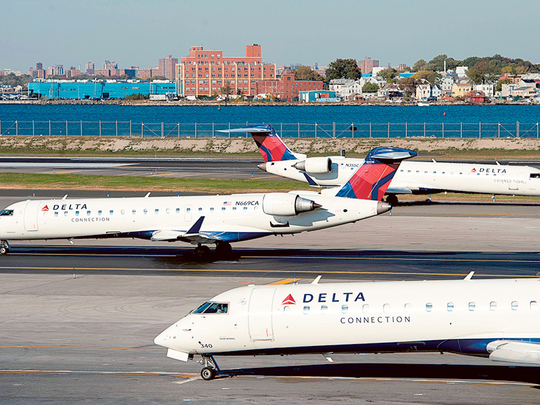
By Justin Bachman, Bloomberg
Another week, another major airline is crippled by some kind of software glitch.; If you feel as if you’re hearing about these incidents more often, you are — but not necessarily because they’re happening more frequently.
Delta Air Lines Inc. suffered an IT outage that led to widespread delays and 280 flight cancellations on January 29 and 30, a problem the carrier said was caused by an electrical malfunction. A week earlier, United Continental Holdings Inc. issued a two=and-a-half hour ground stop for all its domestic flights following troubles with a communication system pilots use to receive data.
These two shutdowns were the latest in what’s been a series of computer crack-ups over the past few years, including major system blackouts that hobbled Southwest Airlines Co. as well as Delta for several days last summer — affecting tens of thousands of passengers. Financially, Delta took a $150 million hit for its debacle last August, while Southwest’s four-day meltdown the previous month cost it about $54 million.
“Delta was already in the midst of investing hundreds of millions of dollars to bolster its IT infrastructure and recovery capabilities,” spokeswoman Kate Modolo said in an email, who explained that the more limited “impact of the January event shows those efforts are paying off.”
Passengers inconvenienced by the more recent stoppages may be forgiven for not cheering too loudly. Add in the roles of Facebook and Twitter in amplifying the anger that comes with being stuck in an airport, or on a tarmac, or circling the runway, and you’ve got a good handle on why these outages are hitting a collective nerve.
Each person on an affected flight has a story about how such a fiasco disrupted plans, and the means to share it. And they do.
Few major carriers have been immune to technological glitches of one sort or another. The underlying theme is that airlines these days are asking their IT to accomplish far more than ever before, from reservations to merchandising to flight operations to customer service.
And all of these systems need to communicate with each other. The more complicated the network, the more prone to failure it becomes.
Now stir those realities with the fact that most airlines deploy a mix of old and new technologies, building some just for themselves to do particular tasks while buying others from vendors. That makes the overall IT operation a motley collection of equipment.
“Airline IT is always going to be an amalgam of legacy and state-of-the-art hardware,” said Robert Mann, an aviation consultant. That combination also increases the need for carriers to continually assess what’s nearing the end of its life, what might break, and how.
“The previously unknown weakest link always emerges,” Mann said. Often unexpectedly.
For better or worse, airline technology platforms now interact with the public much more closely than in bygone days when the business of flight was conducted mostly via mainframe. Passengers access their reservations to change flight plans, seats, and meal preferences.
This digital interaction often involves multiple areas of an airline’s operation, which can increase the burden on systems. The industry’s widespread consolidation over the past decade has amplified the repercussions when a glitch causes paralysis: US airlines are the largest the world has ever seen, with load factors near record highs.
That passenger scale greatly increases the impact of a system outage. Far from skimping on their IT necessities, airlines enlarged by takeovers are spending more these days. They want to capture the many benefits of technology that can sniff out inefficiencies, market their wares better, and customise the travel experience so you’ll spend more.
Mergers have also led to some new investments as carriers found that replacing some systems was superior to patching together old ones. American Airlines Group Inc., for example, built a new revenue-management platform as part of its union with US Airways. Southwest executives are neck deep in a $500 million overhaul of their information technology, installing a new operations system from Amadeus IT Holding SA.
Southwest aims to integrate much of that new IT later this year.; But even with the increased spend on technology, airlines are different from other industries in that they are limited not just by historically thin profit margins, but by the cost of flight safety, which will always be job No.1.
For example, as a percentage of revenue, banks and financial services firms spent 6.8 per cent last year on IT, according to data compiled by technology researcher Gartner Inc. The transport industry, including airlines, spent only 3.2 per cent of revenue.
“The core challenge for investments in resilience is quantifying the cost of improvements relative to the business impact of an outage,” said Mark Jaggers, a Gartner analyst. “While airlines will look at the associated revenue or profit that they lose due to an outage, the impacts to their customers’ experience is not part of that calculation.”
An airline’s goal is to manage nimbly when a problem materialises and to minimise the effect on customers and the network. “How quickly can they manage an outage and then recover from it?” Jaggers said, describing the approach as similar to the way carriers respond to major weather events.
Still, considering the manner in which airline tech is taxed 24 hours per day, 365 days per year, the carriers can boast a “vanishingly small” failure rate for their overall systems, Mann said. “In general, the big airlines are quite conscientious about their technology investments,” said Dolly Wagner-Wilkins, senior vice president-solutions delivery at Sabre Corp., a major vendor of airline technology based in Southlake, Tex.; “The job for airline IT professionals is to bulletproof it and create fail-over redundancy,” Mann said. “Which they think they have done, until the next headline failure occurs.”












